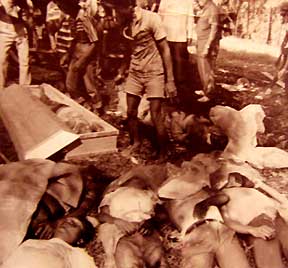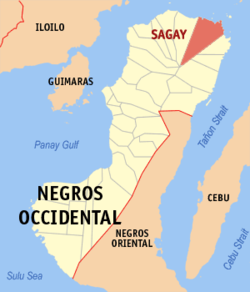
The Escalante massacre was an incident on September 20, 1985, in Escalante, Negros Occidental, Philippines, where government paramilitary forces gunned down civilians engaged in a rally in commemoration of the 13th anniversary of the declaration of martial law. It is also called Escam - portmanteau of "Escalante" and "massacre", and sometimes Bloody Thursday, though the massacre occurred on a Friday.

Extrajudicial killings and forced disappearances in the Philippines are illegal executions – unlawful or felonious killings – and forced disappearances in the Philippines. These are forms of extrajudicial punishment, and include extrajudicial executions, summary executions, arbitrary arrest and detentions, and failed prosecutions due to political activities of leading political, trade union members, dissident or social figures, left-wing political parties, non-governmental organizations, political journalists, outspoken clergy, anti-mining activists, agricultural reform activists, members of organizations that are alleged as allied or legal fronts of the communist movement or claimed supporters of the NPA and its political wing, the Communist Party of the Philippines (CPP). Other frequent targets are ancestral land rights defenders, Indigenous rights activists, environmentalists, and human rights workers.

The Mamasapano clash was a shootout that took place during a police operation by the Special Action Force (SAF) of the Philippine National Police (PNP) on January 25, 2015, in Tukanalipao, Mamasapano, then-undivided Maguindanao. The operation, codenamed Oplan Exodus, was intended to capture or kill wanted Malaysian terrorist and bomb-maker Zulkifli Abdhir and other Malaysian terrorists or high-ranking members of the Moro Islamic Liberation Front (MILF).
The Ninoy Aquino International Airport bullet-planting scandal, locally known as tanim-bala or laglag-bala, was a scandal in the Philippines that began in September 2015 and lasted until early 2016, in which airport security personnel at Ninoy Aquino International Airport (NAIA) in Metro Manila were alleged to have planted bullets in the luggage of passengers in order to extort money from them. Victims of the alleged plot were generally Overseas Filipino Workers, but also included non-Filipinos such as foreign tourists.
2017 in the Philippines details events of note that happened in the Philippines in 2017.
The following is the timeline of events of CPP-NPA-NDF rebellion, a conflict between the government of the Philippines, the Communist Party of the Philippines (CPP), the New People's Army (NPA) and the National Democratic Front (NDF).

The Philippine drug war, known as the War on Drugs, is the intensified anti-drug campaign that began during the administration of President Rodrigo Duterte, who served office from June 30, 2016, to June 30, 2022. The campaign reduced drug proliferation in the country, but has been marred by extrajudicial killings allegedly perpetrated by the police and unknown assailants. By 2022, it is estimated by human rights organizations that more than 20,000 civilians have been killed in "anti-drug operations" carried out by the government and its supporters.

Rolando Rosal Espinosa, the mayor of Albuera, Leyte, died on November 5, 2016, at the Baybay City Provincial Jail. He was detained at the jail due to his arrest for illegal drug possession in October 2016. According to the Criminal Investigation and Detection Group (CIDG), Espinosa was killed during a shootout that he initiated when the CIDG came to the jail to serve him a search warrant. Espinosa's death occurred amid allegations that he was involved in the drug trade by President Rodrigo Duterte, who initiated the Philippine Drug War intending to kill criminals using or distributing drugs. The Commission on Human Rights and Karapatan have held Duterte accountable for Espinosa's death, with Senate condemning the death as an instance of extrajudicial killing.

Jee Ick-Joo was a South Korean businessman kidnapped by two policemen and later found dead on October 18, 2016, within the grounds of Camp Crame, the headquarters of the Philippine National Police (PNP). A funeral parlor cremated his remains and flushed his ashes down a toilet. The policemen who kidnapped him were charged with kidnapping, carnapping, and homicide, while the officer who allegedly planned the attack was acquitted.
The 2017 Bulacan massacre is a massacre that happened on June 27, 2017, in which the assailants killed 5 members of a family inside their home in San Jose del Monte, Bulacan, Philippines. The authorities listed five persons of interest involved in the massacre. Within two weeks after the incident, three of the five persons of interests had been killed by unknown assailants within different areas in Bulacan.

Protests against Former President Rodrigo Duterte escalated on November 18, 2016, following Duterte's support of the burial of the late president Ferdinand Marcos. These series of protests are mostly conducted by progressive groups and other opposing figures mainly due to the ongoing war on drugs, the declaration of martial law in Mindanao, and employment issues such as contractual terms being applied by companies and inflation which occurred due to the passage of the Tax Reform for Acceleration and Inclusion Law. Other causes of the protests include the government's response to the COVID-19 pandemic in the country, the passage of the Anti-Terrorism Act of 2020, and the shutdown and franchise denial of ABS-CBN.
At dawn of Sunday, July 30, 2017, Criminal Investigation and Detection Group (CIDG) and the Ozamiz City police conducted a simultaneous raid in the house of the Parojinogs in Ozamiz and other associated properties, leaving 15 persons killed, including incumbent Mayor Reynaldo Parojinog and his wife. Another member of the Parojinog family died in the hospital three days after the raid. Parojinog is the third mayor to be killed during the course of country's war on drugs after Rolando Espinosa of Albuera, Leyte eight months prior and Samsudin Dimaukom of Datu Saudi-Ampatuan, Maguindanao nine months prior.
2018 in the Philippines details events of note that happened in the Philippines in 2018.

The following is a timeline of protests against Rodrigo Duterte, the 16th President of the Philippines, and his policies. Issues were addressed in the protests including the war on drugs, employment issues, anti-terror law, and the government's response to the COVID-19 pandemic.
2019 in the Philippines details events of note that have occurred in the Philippines in 2019.
The Negros killings were a series of targeted assassinations carried out by unidentified gunmen in the provinces of Negros Oriental and Negros Occidental in the Philippines. Some of the victims involved were suspected communists or sympathizers. Following the killings, Memorandum Order No. 32 was signed by Executive Secretary Salvador Medialdea on November 23, 2018, upon the orders of President Rodrigo Duterte deploying additional troops to the provinces of Negros Oriental, Negros Occidental, Samar, and the Bicol Region to "suppress sporadic acts of violence" allegedly committed by lawless groups and to "prevent such violence from spreading and escalating elsewhere in the country." Even after the memorandum was signed, the incidence of killings continued. According to the Defend Negros Movement, the first recorded extrajudicial killing on Negros Island was Alexander Ceballos on January 20, 2017. The group also alleged that at least 84 persons have been killed since 2017.
In the Philippines, red-tagging is the labeling of individuals or organizations as communists, subversives, or terrorists, regardless of their actual political beliefs or affiliations. It is a type of harassment and has pernicious effects on its targets. Red-tagging has been practiced by security forces, government officials or shills.

On December 20, 2020, a shooting incident occurred in Paniqui, Tarlac, Philippines, when a police officer, Jonel Nuezca, fatally shot two of his neighbors, Sonia and Frank Gregorio, after a heated argument over an improvised noisemaker (boga). The victims' relatives and the perpetrator's underage daughter were present at the scene of the crime and witnessed the incident. The incident was caught on camera and went viral on social media, sparking nationwide outrage and reigniting the discussion over police brutality and human rights violations in recent years.
The 2021 Calabarzon raids, also referred to as Bloody Sunday and COPLAN ASVAL, were a series of operations conducted by the Philippine National Police (PNP) and the Philippine Army in Calabarzon, Philippines, on March 7, 2021, that resulted in the killing of nine activists and the arrest of six individuals. The victims were left-wing activists and environmentalists, including six who were killed in Rizal, two in Batangas, and one in Cavite.
Keith Absalon, a collegiate footballer who played for the FEU Tamaraws in the University Athletic Association of the Philippines (UAAP) and his cousin, Nolven, were killed when they ran over an explosive, reportedly a landmine or an improvised explosive device, that was set up by the New People's Army (NPA) in June 2021 in Masbate City, Philippines.









